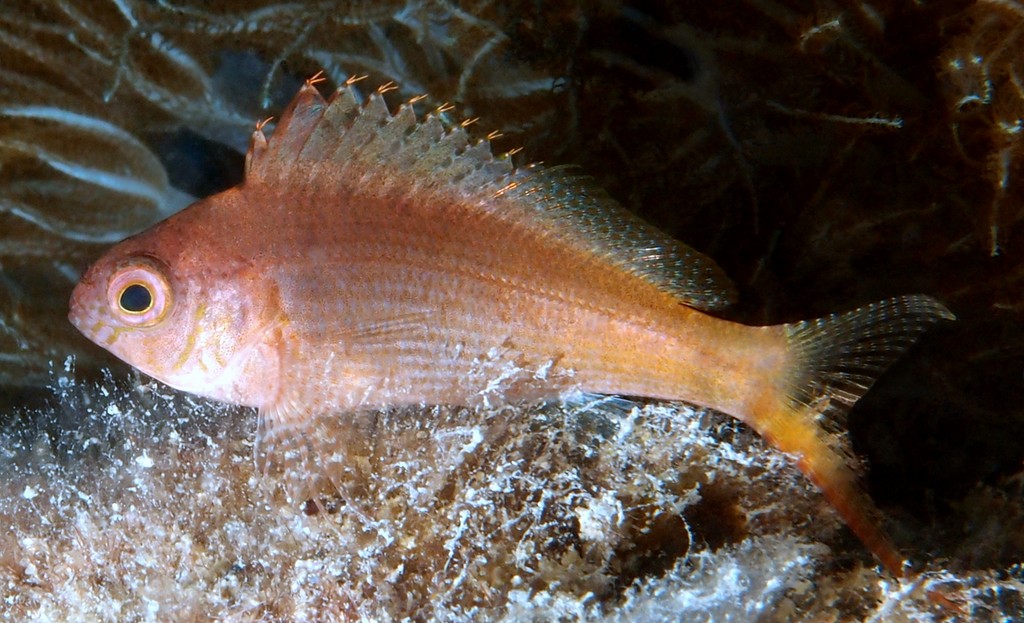CYPRINOCIRRHITES POLYACTIS - (BLEEKER, 1874)
Actinopterygii (Gigaclass) > Actinopteri (Class) > Teleostei (Subclass) > Centrarchiformes (Order) > Cirrhitioidei (Suborder) > Cirrhitidae (Family) > Cyprinocirrhites (Genus)
Cirrhite à nombreux rayons, Épervier à queue d'hirondelle, Lyretail hawkfish, Swallowtail hawkfish, Swaelstert-valkvis, Svalehalet falkefisk, Uigonbe, ウイゴンベ, 红燕子,
Synonymes
Cirrhitichthys polyactis (Bleeker, 1874)
Ctprinocirrhites polyactis (Bleeker, 1874)
Cyprinocirrhites stigma (Fowler, 1943)
Cyprinocirrhites ui (Tanaka, 1917)
-------------------------
Description
Dorsal spines (total): 10; Dorsal soft rays (total): 16-17; Anal spines: 3; Anal soft rays: 6-7 (usually: 6); Pectoral fins rays: 14, uppermost ray and lower 6 rays unbranched; Lateral line scales: 45-49; Three rows of scales above lateral line; Four rows of large scales on cheek; Palatine teeth present; Gill rakers: 3-4 + 10-13. Body depth: 2.7-2.8 in SL. Numerous short filaments at the tip of each dorsal spine. It has a greatly elongated first dorsal ray (in the middle of the dorsal fin), long lower pectoral rays and a lunate caudal fin with filamentous upper an lower rays. Max. length: 15.0 cm TL. Depth range: 10 - 132 m.
Color
Juveniles bright orangish gold.
Adults body pale yellowish pink to orange-brown, and distal half of dorsal fin slightly dusky.
Etymology
Cyprinocirrhites: from Latin, cyprinus = carp + from Latin, cirrus = curl, fringe.
polyactis: from Greek, polus = many, much + from Greek, actis = ray, a star-shaped spicule. Referring to 16-17 rays in soft portion of dorsal fin (the most in the family).
Original description: Cirrhitichthys polyactis Bleeker, 1874 - Type locality: Ambon Island, Molucca Islands, Indonesia.
Distribution
Indo-West Pacific: Eastern Cape and KwaZulu-Natal (South Africa), East Africa (Mozambique, Tanzania, Kenya), Seychelles, Madagascar and western Mascarenes (La Réunion, Mauritius), east to Marquesas Islands (French Polynesia), north to Kagoshima Prefecture (southern Japan), south to Australia, New Caledonia, northern New Zealand and Tonga.
Cirrhite à nombreux rayons, Épervier à queue d'hirondelle, Lyretail hawkfish, Swallowtail hawkfish, Swaelstert-valkvis, Svalehalet falkefisk, Uigonbe, ウイゴンベ, 红燕子,
Synonymes
Cirrhitichthys polyactis (Bleeker, 1874)
Ctprinocirrhites polyactis (Bleeker, 1874)
Cyprinocirrhites stigma (Fowler, 1943)
Cyprinocirrhites ui (Tanaka, 1917)
-------------------------
Description
Dorsal spines (total): 10; Dorsal soft rays (total): 16-17; Anal spines: 3; Anal soft rays: 6-7 (usually: 6); Pectoral fins rays: 14, uppermost ray and lower 6 rays unbranched; Lateral line scales: 45-49; Three rows of scales above lateral line; Four rows of large scales on cheek; Palatine teeth present; Gill rakers: 3-4 + 10-13. Body depth: 2.7-2.8 in SL. Numerous short filaments at the tip of each dorsal spine. It has a greatly elongated first dorsal ray (in the middle of the dorsal fin), long lower pectoral rays and a lunate caudal fin with filamentous upper an lower rays. Max. length: 15.0 cm TL. Depth range: 10 - 132 m.
Color
Juveniles bright orangish gold.
Adults body pale yellowish pink to orange-brown, and distal half of dorsal fin slightly dusky.
Etymology
Cyprinocirrhites: from Latin, cyprinus = carp + from Latin, cirrus = curl, fringe.
polyactis: from Greek, polus = many, much + from Greek, actis = ray, a star-shaped spicule. Referring to 16-17 rays in soft portion of dorsal fin (the most in the family).
Original description: Cirrhitichthys polyactis Bleeker, 1874 - Type locality: Ambon Island, Molucca Islands, Indonesia.
Distribution
Indo-West Pacific: Eastern Cape and KwaZulu-Natal (South Africa), East Africa (Mozambique, Tanzania, Kenya), Seychelles, Madagascar and western Mascarenes (La Réunion, Mauritius), east to Marquesas Islands (French Polynesia), north to Kagoshima Prefecture (southern Japan), south to Australia, New Caledonia, northern New Zealand and Tonga.
Biology
Found on steep slopes and around small coral heads exposed to currents. Hovers several meters above the bottom and feeds mainly on pelagic crustaceans, copepods, and other animals of the plankton. Also found around sponges.
Last update: 11, May 2024
Found on steep slopes and around small coral heads exposed to currents. Hovers several meters above the bottom and feeds mainly on pelagic crustaceans, copepods, and other animals of the plankton. Also found around sponges.
Last update: 11, May 2024
